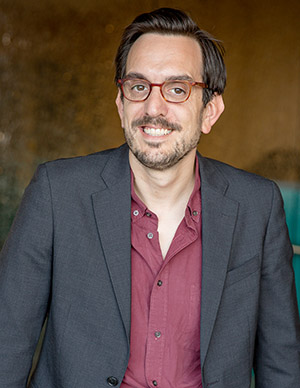
Noah Shenker
Each week, we will profile a scholar who will present his or her research at the Center for Advanced Genocide Research's upcoming conference Digital Approaches to Genocide Studies, Oct. 23-24, 2017.
Inspired by USC Shoah Foundation’s New Dimensions in Testimony (NDT) project, which renders Holocaust survivor accounts as interactive witnesses, Noah Shenker of Monash University’s Holocaust and Genocide Studies program set out on a project of his own – an effort to dissect how testimonies of the Holocaust will be structured in the 21st century, with the NDT pilot as a case study.
His research – which he will present in October at USC Shoah Foundation’s 2017 International Conference “Digital Approaches to Genocide Studies,” co-sponsored by the USC Mellon Digital Humanities Program – will take the pilot featuring survivor Pinchas Gutter and examine it through the lenses of critical debates in Holocaust and Genocide Studies, testimony, and documentary and media studies.
“With my collaborator Dr. Dan Leopard from Saint Mary’s College of California, we are presenting our paper ‘Pinchas Gutter: The Virtual Holocaust Survivor as Embodied Archive,’” Shenker said. “It explores the NDT as a site for challenging traditional conceptions and applications of testimony.”
In an initial call for papers, USC Shoah Foundation asked academics to investigate the ways in which digital tools and methods, new media and information technologies can help us to challenge conventional wisdom regarding the Holocaust and Genocide Studies by raising new questions, improving our understandings, deepening our analyses, widening our fields of view and pioneering new approaches.
The two-day conference, which will be held at the University of Southern California in Los Angeles, invited scholars from across the globe to converge and discuss the relationship between digital methodologies, practices, ethics and the nature of contemporary Holocaust and Genocide Studies.
A 6a Foundation and N. Milgrom Senior Lecturer in Holocaust Genocide Studies within the Australia Centre for Jewish Civilisation at Monash University, Shenker is one of over a dozen scholars speaking at the event, which will cover topics ranging from the netnography of digital autobiographical documentary to the usefulness of augmented reality technologies such as NDT in sharing the memories of places of genocide.
“Given the Institute’s role in developing the NDT project and considering the impressive collection of scholars on hand for the conference, the event presents an invaluable opportunity to further refine and debate our project,” Shenker said. “Dan Leopard and I are currently in the process of finalizing our paper for publication at a peer-reviewed journal and look forward to receiving input that will shape the final form of the piece.”
Their paper, according to an abstract submitted to the Institute, will explore NDT’s capacity as a tool for research, education and other uses.
“The work of the NDT project represents an important, albeit challenging opportunity in preserving the memory of Holocaust and other genocide survivors after they are no longer alive to tell their stories,” Shenker said. “It is essential to examine the limits and possibilities of this and other forms of testimonial technology as they are never value-neutral.”
Though Shenker has never been directly affiliated with the Institute, he completed his doctoral work at USC not long after the Institute relocated to its current home at USC’s Leavey Library and has conferred with Institute staff about his research, which centers on trauma and memory studies, and film and media studies.
But even through his limited involvement with USC Shoah Foundation, he recognizes its contributions to the field and his own research, and the value of its Visual History Archive, a collection of 54,000 digitized and fully searchable video testimonies from survivors and other eyewitness of the Holocaust, the Rwandan, Guatemalan and Armenian genocides and the Nanjing Massacre in China.
“Although USC Shoah Foundation, along with other repositories of testimony such as the Fortunoff Archive and U.S. Holocaust Memorial Museum, have preserved in total over 60,000 testimonies of the Holocaust,” Shenker said, “it is not enough to simply preserve their holding. It is essential to ensure that they are rigorously used for research, teaching and other purposes.”
Such conferences provide a grounds and opportunity for this to happen. The symposium will begin October 23 in Los Angeles.